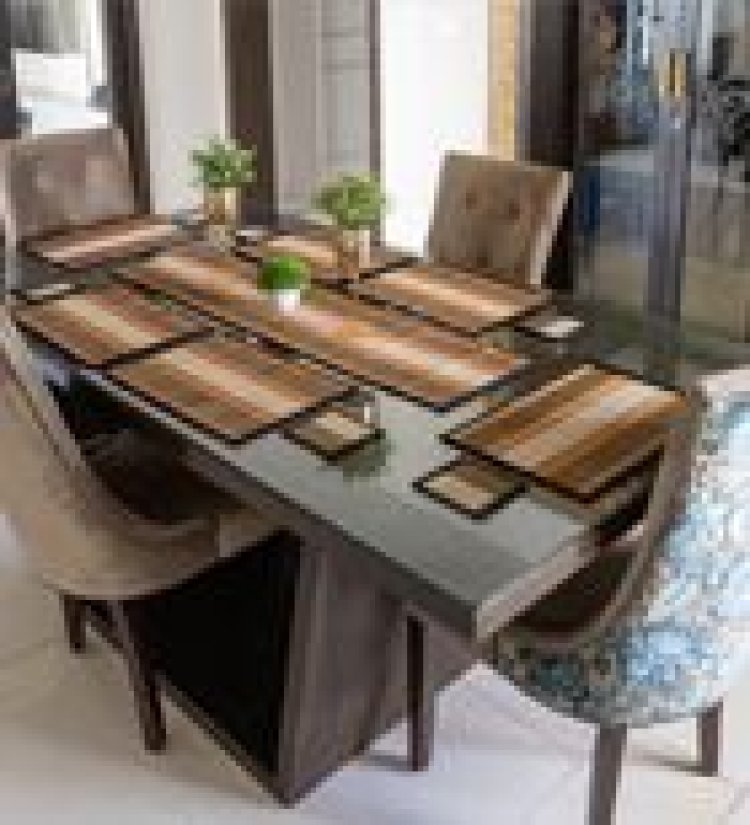Popular Materials for Dining Table Designs
Selecting the right material for your dining table is an important decision that influences both the look and functionality of your dining space.
Share this Post to earn Money ( Upto ₹100 per 1000 Views )

Choosing the right material for your dining table is crucial, as it affects not only the table's aesthetic appeal but also its durability and functionality. The material you select should complement your dining room's decor while meeting your lifestyle needs. Here are some of the most popular materials used in dining table design, each offering unique benefits and characteristics.
1. Solid Wood
Solid wood is a timeless choice for dining tables, known for its durability, warmth, and natural beauty. Whether you prefer the rustic charm of oak or the rich tones of walnut, wood offers a wide range of options to suit various styles.
Key Features:
- Durability: Solid wood tables are built to last, often becoming heirloom pieces passed down through generations.
- Versatility: Wood can be stained, painted, or left in its natural state, allowing for a variety of finishes and looks.
- Maintenance: Regular polishing and proper care can maintain the table’s appearance over time, though wood can be susceptible to scratches and water damage.
Popular Wood Types:
- Oak: Known for its strength and grain pattern, oak is a popular choice for traditional and rustic designs.
- Walnut: With its rich, dark color, walnut adds a touch of luxury to any dining room.
- Maple: A lighter wood with a smooth grain, maple is often used in contemporary designs.
2. Glass
Glass dining tables are a modern and stylish option, ideal for smaller spaces or contemporary interiors. The transparency of glass creates an illusion of space, making the room feel more open.
Key Features:
- Aesthetic Appeal: Glass tables offer a sleek, minimalist look that can enhance modern or industrial decor.
- Easy Maintenance: Glass is easy to clean and resistant to spills and stains, though it can show fingerprints and smudges.
- Light Reflection: The reflective surface of glass can brighten up a room by bouncing light around.
Considerations:
- Safety: Tempered glass is recommended for its durability and safety, as it’s less likely to shatter than regular glass.
- Frame Material: Glass tabletops are often paired with metal or wooden frames, allowing for various design combinations.
3. Marble
Marble dining tables exude luxury and elegance, making them a statement piece in any dining room. Each marble slab is unique, with natural veining that adds to its appeal.
Key Features:
- Luxurious Appearance: Marble offers a sophisticated look that can elevate the decor of your dining space.
- Unique Patterns: The natural veining in marble ensures that no two tables are exactly alike.
- Durability: While strong, marble is a porous material that requires sealing to prevent stains and damage.
Considerations:
- Weight: Marble is heavy, requiring sturdy supports and careful placement.
- Maintenance: Regular sealing and cautious cleaning are necessary to maintain marble’s appearance and prevent etching.
4. Metal
Metal dining tables, or those with metal accents, are favored for their industrial and contemporary styles. Metal is durable, versatile, and can be combined with other materials like wood or glass for a mixed-media design.
Key Features:
- Strength: Metal tables are highly durable and resistant to wear and tear.
- Versatility: Available in various finishes such as matte, polished, or brushed, metal can fit into industrial, modern, or eclectic spaces.
- Low Maintenance: Metal is easy to clean and maintain, though it can be prone to scratches and dents.
Popular Metal Types:
- Stainless Steel: Common in modern and industrial designs, stainless steel is sleek and durable.
- Iron: Often used in rustic or vintage designs, iron can be shaped into intricate patterns for a decorative effect.
- Aluminum: Lightweight and resistant to rust, aluminum is ideal for both indoor and outdoor dining tables.
5. Engineered Wood
Engineered wood, such as MDF (Medium-Density Fiberboard) or plywood, is a cost-effective alternative to solid wood. It’s widely used in contemporary and minimalist designs due to its smooth surface and affordability.
Key Features:
- Affordability: Engineered wood is less expensive than solid wood, making it accessible for budget-conscious buyers.
- Smooth Finish: The uniform texture of engineered wood allows for a sleek, modern look.
- Eco-Friendly: Many engineered wood products are made from recycled materials, making them an environmentally friendly option.
Considerations:
- Durability: Engineered wood is not as durable as solid wood and can be prone to damage if not properly maintained.
- Finishing: It can be finished with veneers or laminates to mimic the appearance of solid wood or other materials.
6. Concrete
Concrete dining tables are a bold and contemporary choice, offering a raw, industrial look. They are known for their strength and durability, making them suitable for both indoor and outdoor use.
Key Features:
- Industrial Aesthetic: Concrete tables fit well in modern, industrial, and minimalist spaces, adding a rugged, unfinished charm.
- Durability: Concrete is extremely durable and resistant to damage, though it requires sealing to prevent staining.
- Customization: Concrete can be molded into various shapes and sizes, allowing for customized designs.
Considerations:
- Weight: Concrete is heavy and may require reinforced flooring or supports.
- Maintenance: Regular sealing is necessary to protect the surface from stains and water damage.
Conclusion
Selecting the right material for your dining table is an important decision that influences both the look and functionality of your dining space. Whether you prefer the timeless beauty of solid wood, the modern elegance of glass, or the industrial charm of concrete, each material offers distinct advantages. Consider your lifestyle, dining room decor, and maintenance preferences when choosing the perfect dining table material to ensure it meets your needs for years to come.















